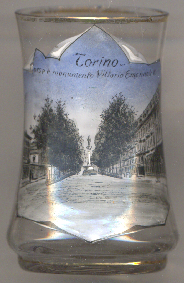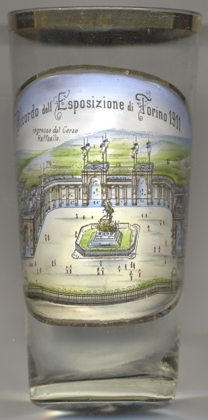

|
| ITALIA | ITALY |
| regione: Piemonte | Piedmont |
| provincia: Torino |
Torino (English: Turin), the capital city of Piedmont, is situated at an elevation of 240 m on the river Po, about 100 km each from France to the west and Switzerland to the northwest, and about 140 southwest of Milano, the capital of adjacent Lombardy. The municipality of Turin has a population of about 871,000 (2019) and thus is the fourth-largest city in Italy after Milano, Rome and Naples. The greater Metropolitan City of Turin has a population of about 2,25 million.
The Taurini were an ancient Celto-Ligurian Alpine people, who occupied the upper valley of the Po River. As a people they are rarely mentioned in history. It is believed that a Roman colony was established after 28 BC under the name of Julia Augusta Taurinorum (modern Turin). After the fall of the Western Roman Empire, the town was conquered by the Heruli and the Ostrogoths, recaptured by the Romans, but then conquered again by the Lombards and then the Franks of Charlemagne (773). The Contea di Torino (countship) was founded in the 940s. In the 12th century, the family of the Counts of Savoy gained control and at the end of the 13th century it was annexed to their duchy. By the Treaties of Utrecht (1713–1715) the Duke of Savoy acquired Sicily, soon traded for Sardinia, and part of the former Duchy of Milan, and was elevated to king; thus Turin became the capital of a European kingdom. Turin, like the rest of Piedmont, was annexed by the French Empire in 1802, thus becoming the capital (préfecture) of the département du Pô (or département de l'Éridan after the ancient name of the river) until the fall of Napoléon in 1814, when the Kingdom of Piedmont-Sardinia was restored with Turin as its capital. In the following decades, the Kingdom of Piedmont-Sardinia led the struggle towards the unification of Italy. In 1861, Turin became the capital of the newly proclaimed united Kingdom of Italy until 1865, when the capital was moved to Florence, and then to Rome after the 1870 conquest of the Papal States. The late 19th century was also a period of rapid industrialization, especially in the automotive sector. After World War I, harsh conditions brought a wave of strikes and workers' protests. Turin was then a target of Allied strategic bombing during World War II, being heavily damaged by the air raids in its industrial areas as well as in the city centre. In the postwar years, Turin was rapidly rebuilt and the city's automotive industry played a pivotal role in the Italian economic miracle of the 1950s and 1960s. In 2006, Turin hosted the Winter Olympic Games.

The  monument to Vittorio Emanuele II [left, no. 4845] is located at the
intersection of Corso Vittorio Emanuele II [shown in the background] and Corso Galileo Ferraris. The
statuary monument atop a set of columns is dedicated to Vittorio Emanuele II, the first king of Italy (King of Sardinia
1849–1861, King of Italy 1861–1878). The monument was paid by his son, King Umberto I, at his own expense.
The monument, in bronze and granite, is the work of architect Pietro Costa. It was erected between 1882 and 1899, amidst
many difficulties, disputes and controversies with the municipality of Turin. The monument reaches an impressive height of
39 metres. Due to its height, it is popularly called The King on the Roofs or Barba Vigiu.
monument to Vittorio Emanuele II [left, no. 4845] is located at the
intersection of Corso Vittorio Emanuele II [shown in the background] and Corso Galileo Ferraris. The
statuary monument atop a set of columns is dedicated to Vittorio Emanuele II, the first king of Italy (King of Sardinia
1849–1861, King of Italy 1861–1878). The monument was paid by his son, King Umberto I, at his own expense.
The monument, in bronze and granite, is the work of architect Pietro Costa. It was erected between 1882 and 1899, amidst
many difficulties, disputes and controversies with the municipality of Turin. The monument reaches an impressive height of
39 metres. Due to its height, it is popularly called The King on the Roofs or Barba Vigiu.

The  Turin International Exposition (Esposizione internazionale dell'industria e del lavoro),
focussing on industry and labour, was held in Turin in 1911. The fair was held in the Parco del Valentino (as were the three
previous Turin fairs in 1884, 1885 and 1902 and the subsequent 1924 Turin fair). The fair covered 247 acres and received
more than 4 million visits.
The picture on glass no. 3916 [left] shows the entrance from Corso Raffaelo. Corso
Raffaelo is to the back of the entrance buiding in the line of sight; behind the entrance building is Corso Massimo
d'Azeglio.
Turin International Exposition (Esposizione internazionale dell'industria e del lavoro),
focussing on industry and labour, was held in Turin in 1911. The fair was held in the Parco del Valentino (as were the three
previous Turin fairs in 1884, 1885 and 1902 and the subsequent 1924 Turin fair). The fair covered 247 acres and received
more than 4 million visits.
The picture on glass no. 3916 [left] shows the entrance from Corso Raffaelo. Corso
Raffaelo is to the back of the entrance buiding in the line of sight; behind the entrance building is Corso Massimo
d'Azeglio.
The  equestrian monument to Duke Amedeo of Savoy [foreground] was created
in 1902 by the sculptor Davide Calandra. While the buildings of the exhibition (icluding the entrance building) have long
since been demolished, the monument still exists. The statue is dedicated to the second son of King Vittorio
Emanuele II of Sardinia (later King of Italy). Not having the right to inherit, Amedeo became a military man and took
part in the wars of independence with Austria. In 1863 he was one of the heirs of the throne in Greece, but refused to rule.
But he became King of Spain in 1870 (Amadeo I), although his ruling did not last long — only
3 years, and after serious unrest he returned to Piedmont. He died in 1890 and was buried in Turin's Basilica di
Superga.
equestrian monument to Duke Amedeo of Savoy [foreground] was created
in 1902 by the sculptor Davide Calandra. While the buildings of the exhibition (icluding the entrance building) have long
since been demolished, the monument still exists. The statue is dedicated to the second son of King Vittorio
Emanuele II of Sardinia (later King of Italy). Not having the right to inherit, Amedeo became a military man and took
part in the wars of independence with Austria. In 1863 he was one of the heirs of the throne in Greece, but refused to rule.
But he became King of Spain in 1870 (Amadeo I), although his ruling did not last long — only
3 years, and after serious unrest he returned to Piedmont. He died in 1890 and was buried in Turin's Basilica di
Superga.
[https://de.wikipedia.org/wiki/Turin, https://en.wikipedia.org/wiki/Turin;
https://it.wikipedia.org/wiki/Monumento_a_Vittorio_Emanuele_II_(Torino);
https://en.wikipedia.org/wiki/Turin_International, https://it.wikipedia.org/wiki/Esposizione_internazionale_di_Torino;
http://www.museotorino.it/view/s/713196ec1aeb4ec99578a35c941fb80b, https://it.igotoworld.com/en/poi_object/316995_monument-of-amedeo-of-savoia-turin.htm,
https://en.wikipedia.org/wiki/Amadeo_I_of_Spain]
![[scale]](lineal.jpg)